April 24, 2019 feature
Developing a dual-gradient ultrafast biomimetic snapping hydrogel material
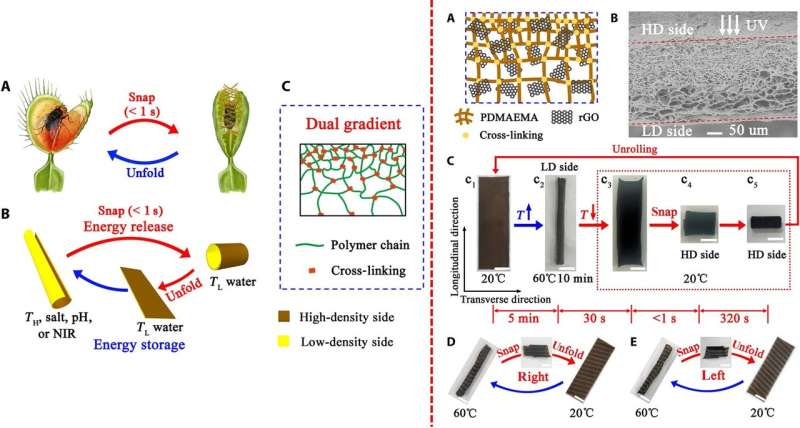
Bioinspired materials are designed and engineered to mimic the biological functions of nature; however fast actuation is an important but challenging task to recreate in the lab. In a recent study, Wenxin Fan and co-workers in the interdisciplinary departments of materials science, engineering, chemistry, biochemistry and macromolecular science in the USA and China, presented a new paradigm to design responsive hydrogel sheets that could exhibit ultrafast and inverse snapping deformation. They engineered the hydrogel sheets with dual-gradient architecture to accumulate elastic energy in the polymers by converting prestored energy for rapid reverse snapping and energy release.
Fan et al. controlled the magnitude and location of stored energy in the hydrogel sheets to program their snapping reaction and achieve different structures and actuation behaviors. They developed a theoretical model thereafter to demonstrate the crucial role of dual gradients and predicted the snapping motion of a variety of different hydrogel materials. The new design principle will provide guidance to engineer actuation materials for applications in tissue engineering, soft robotics and as active medical implants. The results are now published in Science Advances.
Shape transformation is ubiquitous in living systems such as carnivorous plants that strategically capture prey, providing a natural source of inspiration to engineer functional shape-transforming materials in the lab. Responsive hydrogels are capable of shape transformation under a variety of stimuli, with promising applications already delivered in soft robotics, drug delivery, tissue engineering and microfluidics.
Scientists have used thermo-responsive polymers such as poly(N,N-dimethylaminoethyl methacrylate) (PDMAEMA) and poly(N-isopropylacrylamide) (PNIPAM) to design such shape-transforming materials. Shape transformation of hydrogels mainly rely on the different swelling rates of hydrogels in different regions of the materials, where the gradual shape evolution is driven via in-plane and out-of-plane mismatch in the changing volume of hydrogels. Present efforts therefore focus on enhancing the shape complexity to diversify the materials response to external stimuli.
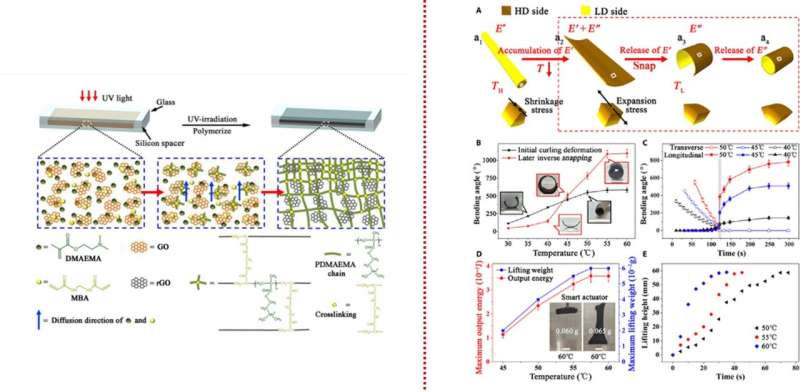
As an example, leaves of the Venus flytrap can rapidly close and capture insects in one-tenth of a second, which is distinct from synthetic hydrogels that have thus far only shown gradual and relatively slow shape transformation. The extremely rapid motion of the Venus flytrap is credited to the accumulation and quick release of energy that can assist the sudden, yet, discontinuous motion essential to develop ultrafast actuators with broad applications in soft robotics through biomimicry. Existing approaches to achieve this type of motion rely on reversible switching between concave and convex structures of bi-stable polymeric sheets – but this strategy only allows limited structural complexity and actuation behavior. As a result, an existing need remains to design new principles of snapping motion that will be interlaced into responsive biomaterials.
In the present work, Fan et al. reported a nature-inspired design of responsive hydrogel sheets that accumulated elastic energy and rapidly released the energy during ultrafast snapping deformation. Using experimental results and theoretical models, the scientists showed that the snapping motion of the hydrogels originated from their dual-gradient (polymer chain density gradient and cross-linking density gradient) structural design. In the experiments they used reduced graphene oxide (rGO)/PDMAEMA composite hydrogel sheets with dual gradient structures as a model system and demonstrated that the sheets could accumulate elastic energy and convert the pre-stored thermal or chemical energy to rapidly snap.
Mechanically, the novel hydrogel could snap in reverse under a second (<1 s), to release the stored elastic energy in response to external stimuli. Fan et al. were able to tune the velocity, angle and location of snapping in the hydrogel sheet to control the position and magnitude of prestored energy. As a result, the scientists were able to program the sheets to achieve different structures and actuation behaviors. They propose to extend the new design principles of snapping deformation to other materials including neat hydrogels and elastomers in future work.
Fan et al. first engineered the composite rGO/PDMAEMA composite hydrogel under ultraviolet (UV)-induced free radical generation of GO (graphene oxide) to initiate polymerization of the DMAEMA (monomer) and N,N'-methylene-bis-acrylamide (MBA; crosslinking agent). They irradiated a mixture of GO, DMAEMA and MBA filled in-between a sealed space with UV light and showed how the light intensity along the side generated a higher concentration of free radicals on the GO surface for faster polymerization. The fabrication process characteristically allowed higher chain density and crosslinking density of the hydrogel, which was confirmed using scanning electron microscopy (SEM), confocal laser scanning microscopy (CLSM), X-ray photoelectron spectroscopy (XPS) and Raman spectra.
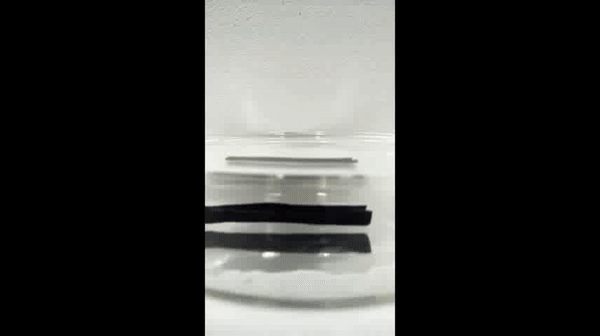
When the scientists submerged the patterned hydrogel material from water at 200C into 600C higher than its volume phase transition temperature, the originally flat composite hydrogel sheet curved up. On replacing it in the 200C water bath, the hydrogel took a completely different route to reverse transform its shape, giving rise to a new intermediate state. Fan et al. observed the rapid, inverse snap (in less than 1 second) associated with a sharply increased bending angle from 38 degrees to 540 degrees, to gradually unroll and become a flat structure as before, in approximately 60 mins. The scientists deduced the inverse snapping of hydrogel sheets as a new mechanism of energy transformation and divided the process to three stages.
(1) Converting part of the prestored thermal/chemical effective energy (E*) into cumulative elastic energy during curled sheet unrolling.
(2) Instantaneous release of accumulated elastic energy (E') in the form of snapping, and
(3) Gradual release of the rest energy (E") to curl further after snapping.
Temperature variation in the experimental setup affected the deformation rate of the hydrogel sheet. As a result, Fan et al. were able to quantitatively program the snapping rate of the sheets by tuning the magnitude of its prestored energy with variable temperatures, to stimulate the gel.
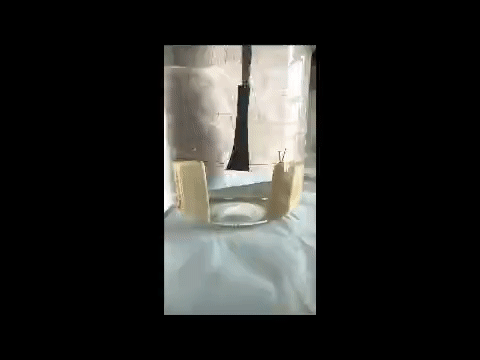
As a proof-of-principle, they demonstrated the self-regulated actuation capabilities, where the pre-stimulated hydrogel sheet snapping mechanism triggered weight lifting in water temperatures varying from 200C to 600C. The maximum weight that could be lifted increased with changing temperature. The scientists provided a concept to control energy storage and release in hydrogels, allowing intelligent materials design with programmable motion instilled with abilities for mass identification and power regulation.
Due to the weak polyelectrolyte nature of PDMAEMA, Fan et al. also showed that the snapping motion could be regulated by stimulating the gel pH through ion strength (IS) variation. As with temperature stimulation, the hydrogel sheets demonstrated similar mechanistic behavior, under a broad range of IS conditions. The new materials were thus built with versatility to surpass the existing limitations of narrow operating conditions in materials engineering.
The scientists also showed that the composite hydrogels were responsive to near-infrared (NIR) light due to photothermal effects of the constituent rGO. They demonstrated programmable folding of the gel sheet into a cube via controlled light exposure and energy storage within the sheet as an example, with great potential in biomedicine for minimally invasive surgical procedures and in soft robotics. The scientists then quantified the snapping process to establish a general criterion for inverse snapping and credited the characteristic nature to the dual-gradient structure of the hydrogel sheet. The scientists verified the general criterion of inverse snapping by comparing the deformation behaviors of bi-layered PNIPAM hydrogel sheets with dual gradients and those with cross-linking density alone. They found that the dual-gradient PNIPAM sheets exhibited inverse snapping motions, while all single-gradient hydrogels only showed conventional simple bending in response to thermal stimulation.
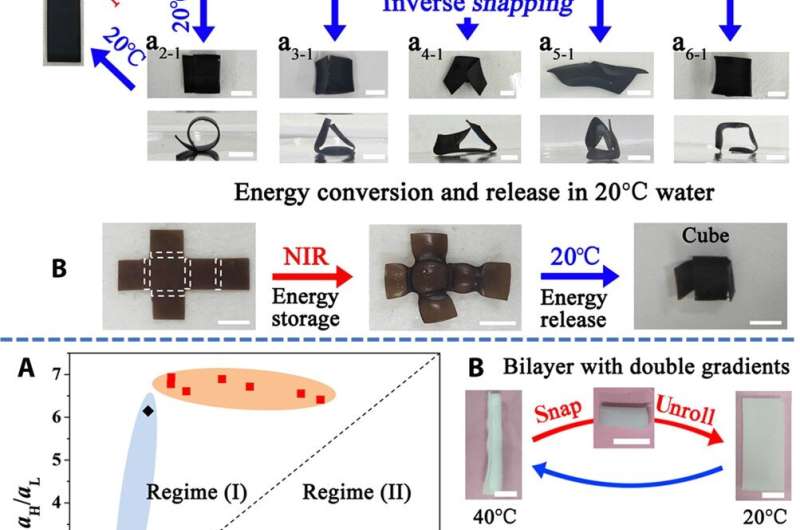
In this way, the scientists demonstrated a general principle to design hydrogels using the energy transformation ability to trigger programmable snapping deformation. They controlled the magnitude and site of energy pre-storage in the hydrogels to program inverse snapping and achieve different actuations and structures. Fan et al. credited the energy transformation-induced snapping to the dual-gradient structure (containing a polymer chain density gradient and cross-linking density gradient). They ultimately proposed a theoretical model to interpret and predict the snapping of hydrogels, which agreed with the experimental observations.
The dual-gradient hydrogel can work directly as a self-propelled, intelligent actuator infused with the ability to identify weights and control power under constant stimuli. The research will provide new insights to rapidly actuate diverse materials alongside practical guidance in the design and development of autonomous actuators, soft robotics and active medical implants in the future.
More information: 1. Dual-gradient enabled ultrafast biomimetic snapping of hydrogel materials DOI: 10.1126/sciadv.aav7174 , advances.sciencemag.org/content/5/4/eaav7174 Wenxin Fan et al., 19 April 2019, Science Advances.
2. A light-driven artificial flytrap www.nature.com/articles/ncomms15546 Owies M. Wani et al. 23 May 2017, Nature Communications.
3. Advances in engineering hydrogels science.sciencemag.org/content … 37/eaaf3627.abstract Yu Shrike Zhang and Ali Khademhosseini. 05 May 2017, Science.
4. Photothermally reprogrammable buckling of nanocomposite gel sheets onlinelibrary.wiley.com/doi/ab … .1002/anie.201412160 Adam W. Hauser, 05 March 2015, Angewandte Chemie (International Edition in English).
Journal information: Science , Science Advances , Nature Communications , Angewandte Chemie
© 2019 Science X Network





















